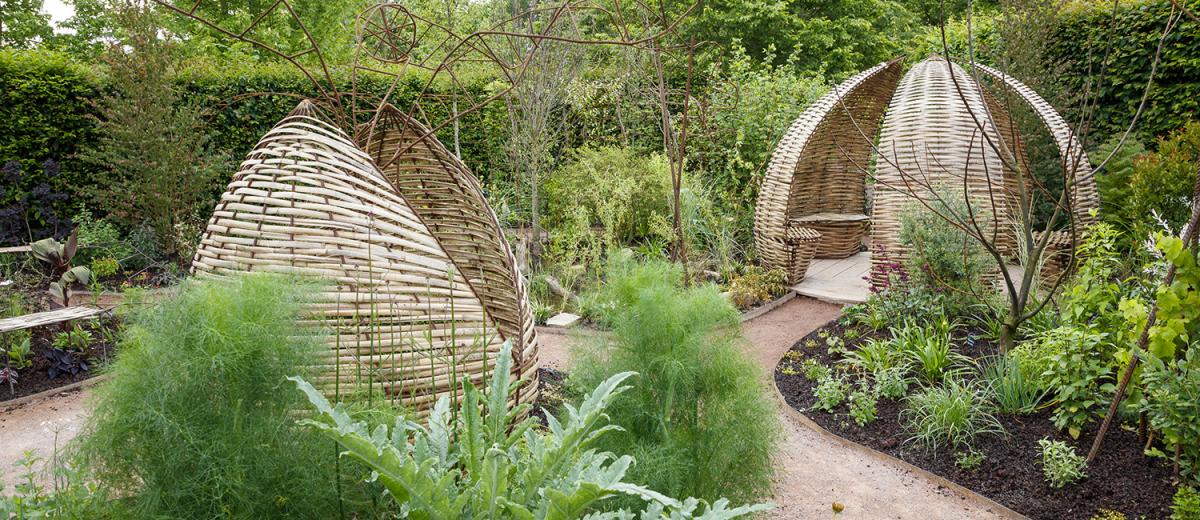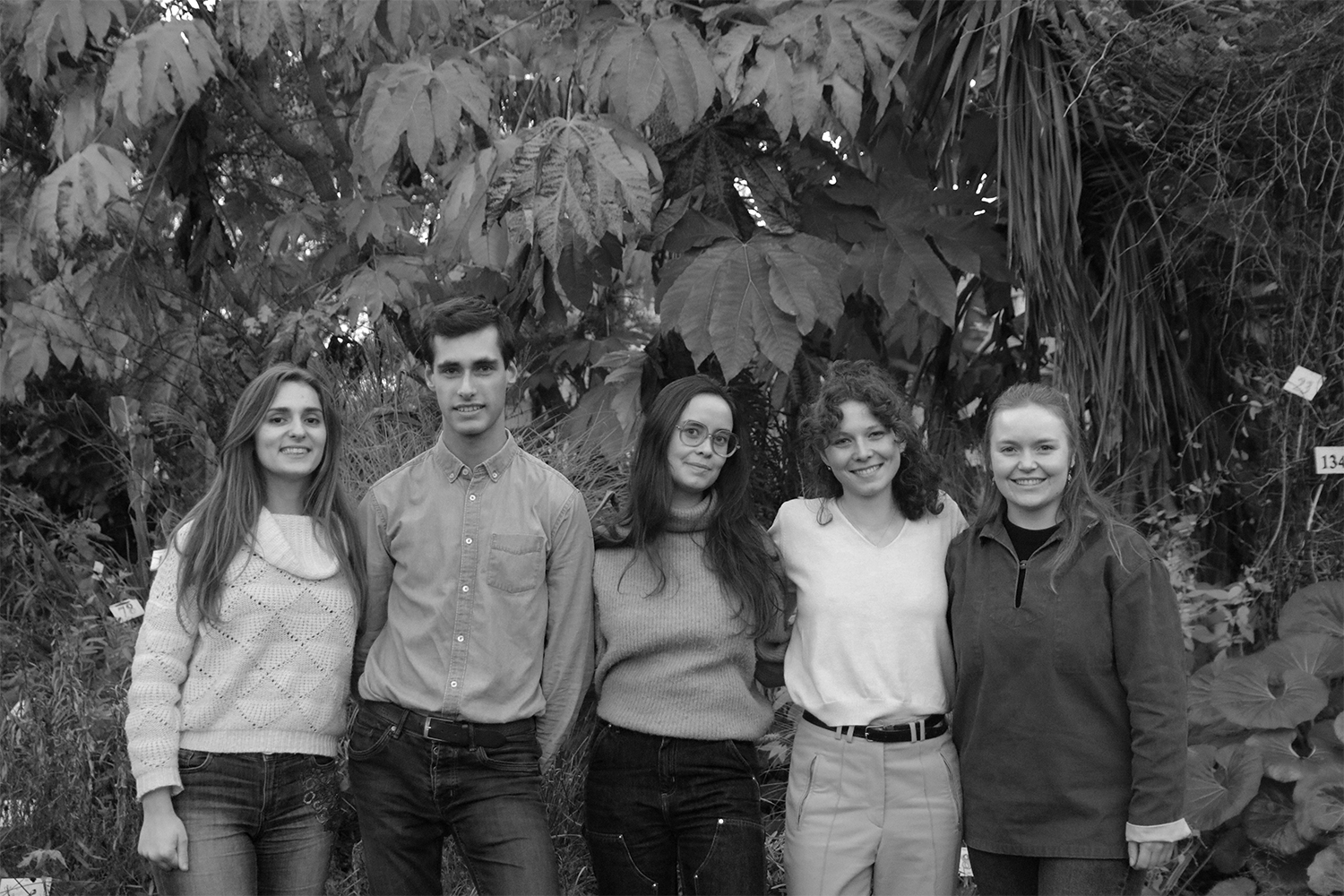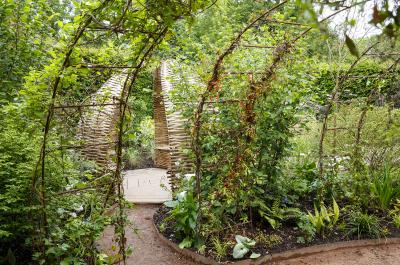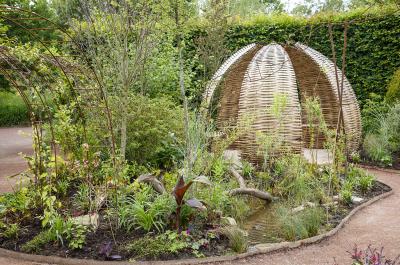14. L’éveil de la graine

Strands of DNA, which are the basic structure behind every living being, guide the exploration of the garden through four plant environments. They form archways, firstly up over a wild garden of indigenous plants, then continue to serve as benches in an ornamental garden, representing a profusion of shapes and colours, and then go on to connect to the food-producing plants of the garden. At the core of this vegetable garden filled with aromatic and medicinal plants, the strands of DNA come together in a giant kokedama, wrapped in woven bamboo and set on a mirror of water. This structure represents the sprouting of a seed, the very beginning of plant life and a condensed illustration of genetic potential. As soon as its environment seems favourable, full of energy, the seed leaves its dormant state. It captures all the energy it needs from the basic elements: water, air and the sun, to sprout and flourish. The visitor is guided towards a flower bud, another step in the recreation of life, which occupies the last quarter of the garden. The bud is preparing for a flower - the source of pollination - to bloom and symbolises the link between the plant and animal worlds. This calming and lightweight structure is a cocoon of shade and freshness, encouraging the visitor to take a moment to rest and call on the senses as they are transported to the scale of insects and small animals. The seed and bud are essential features of the plant world and longevity of gardens. This garden is a chance to embrace the balance of ecosystems.
DESIGNERS

Aline Bignon has always been interested in plants but it wasn’t her first choice of career. As a child she wanted to work with either animals or flowers. After studying for her scientific French baccalaureate in 2017 and then completing a one-year preparatory course to be a veterinary surgeon, she then decided to go and study at the Institut Agro Rennes-Angers in September 2018. Choosing to study at this school was a choice that echoed the vision her parents had passed on to her throughout her childhood, that nature is about learning to observe every detail in a garden, from a tiny insect to a hundred-year-old tree. She learnt everything there is to know about the garden, through observational workshops, gardening and tasting the fruit and vegetables from the garden all year round. In this family garden, she developed her observational skills, a taste for gardening and her understanding of the micro-habitats found in the garden at varying moments throughout the year. This upbringing eventually became a way of life. This manifested itself first and foremost in her studies, but also in the walking she enjoyed in her free time.. Walking was for her a way to observe the beauty of the elements, when a mountain is reflected in a vast Scottish lake, for example, or when the sun rises up over the villages nestled in a cirque on Reunion Island. On these walks, while waiting for a bus or on a camping adventure, she always keeps her sketchbook on hand for when she wants to draw the landscapes before her and keep a memory of them with her. This tool is essential for her and helps her understand and admire these landscapes. She also meets people thanks to this tool, which is yet another incentive to go hiking. She is convinced that plant species belong in the urban environment, both for the environment and for the well-being of the people there. She hopes to develop her skills as a project manager, work with a range of different players and be able to communicate ideas and projects through drawings and words.
Sterenn Kerloeguen was born in Brittany in the heart of the Armorica Regional Natural Park, and has always been inspired by the landscapes and environment around her. This fascination concerned the natural heritage just as much as architectural or cultural heritage, sparking a desire to safeguard these heritage sites. She has always loved nature and her appreciation of walks along the seafront or across the moors of the Monts d’Arée, her keen interest in the vegetable gardens tended by her parents and grandparents, and her passion for hiking in the mountains on holiday all attest to this. These interests are a constant source of inspiration in her life. Rooted in this environment since her childhood, she has had the privilege of observing the evolution of the landscapes over time, and this in turn developed her desire to support both populations and spaces through these regional transformations. After graduating from high school, she made the obvious choice to study at the Institut Agro Rennes-Angers, formerly the Institut National d’Horiculture, where she specialised in the field of horticulture and landscape. Her various work placements at botanical gardens and design offices only confirmed her chosen career path. This path naturally led her to Germany where she gained a double degree in landscape architecture at the Hochschule Weihenstephan-Triesdorf. This experience was highly rewarding and she discovered other ways of approaching and developing landscapes. Today, her goal is to make an active contribution to the protection and evolution of territories, working alongside local authorities and design offices.
Marina Seguin grew up in a small town in the Puy de Dôme region of France in the heart of the Limagne plain. She grew up as part of a big family who all worked in the farming sector and she was always surrounded by nature. She spent her childhood at family gatherings and traditional celebrations in the countryside. At the age of 10, she would spend most of her free time reading, riding her bike and doing arts and crafts. She travelled to parallel universes through literature and fantasy novels in particular, discovering wonderful imaginary landscapes there. Her arts and crafts activities helped her explore her creativity. She didn’t choose to specialise until after her French baccalaureate. She had always been very good with animals and was keen on biology, and so she chose to enrol onto a preparatory course in biology, chemistry, physics and earth sciences (BCPST). At the end of this course when she had to consider a future career path, she decided to study at the landscape engineering school in Angers. She was selected to attend the Agrocampus Ouest (now the Institut Agro) for her third year and that’s where she was able to put her creativity to good use for the first time since her art classes at high school. She was delighted with this change and could finally combine her scientific knowledge with the more visual, sensitive side of landscape. She is determined to explore the many sides of this field and so as she embarks upon her final year of studies, she is also keen to participate in a number of varied projects, including the International Garden Festival at Chaumont-sur-Loire.
Mathilde Verdier grew up in Rennes and has always been a city girl. However, she would often explore the forest or her grandparents’ garden. At their side, she learnt to cherish the earth. This earth has now become her material of choice, and she shapes it into ceramics. Colours are also key to her creations, and she is particularly talented in the way she blends them together. She loves the enjoyment and freedom she feels in the great outdoors, and makes sure she always considers the diversity of her environments from a curious and attentive perspective. During her studies at the Institut Agro Angers, she nurtured her intimate relationship with the landscape while developing a rational and operational approach to her work. She is creative and enthusiastic and is always looking to seize opportunities to conjure up new possibilities. Taking a group approach, she is keen to encourage meaningful projects, particularly for the Expo Flo (floral exhibition that takes place every other year at the Institut Agro Angers), in-company experiences, a semester of architectural studies in Madrid and for the International Garden Festival at Chaumont-sur-Loire. She is proud to bring this garden project to life in partnership with other participants. Mathilde is hoping to give visitors the same desire to explore the outdoors that her grandmother awakened in her.
Florian Berjamin is from Saumur and has always lived in the hills of the Loire, surrounded by the Saumurois vineyards. As the son and grandson of landscapers, he grew up in contact with nature thanks to his upbringing and the huge family garden. His passion for nature and birds in particular developed as he spent a lot of time outdoors and tended to the vegetable garden and orchard. As a result, he became a volunteer for the French Bird Protection League (LPO) at the age of 8. Despite some uncertainties as to which path to take after his French baccalaureate, landscaping soon became the obvious choice for him. He was looking for a profession where he could practice both drawing and design, such as automobile design or architecture, but the landscaping profession meant that he could also combine these fields with nature and plant life. He therefore chose to study landscape engineering at the Agrocampus Ouest (now known as the Institut Agro) in September 2019. In his third year of study, he spent one year in Germany on a landscaping course at the Hochschule Weihenstephan-Triesdorf (HSWT) in Freising. Thanks to the many projects he worked on, he adopted a different view of landscaping. He also took part in several landscaping competitions, including the international student competition, Le Notre 2022-2023, where he was selected as a finalist. He loves to combine benefits for nature and quality of life for people, and has a particular interest in natural swimming pools. On an internship in Austria, the country where this concept was first created in the 1980s, he learnt a great deal while carrying out research for a company specialised in this field. He is now finishing his studies and plans on designing and creating private gardens for individuals. Maybe one day he might take over the family business.



